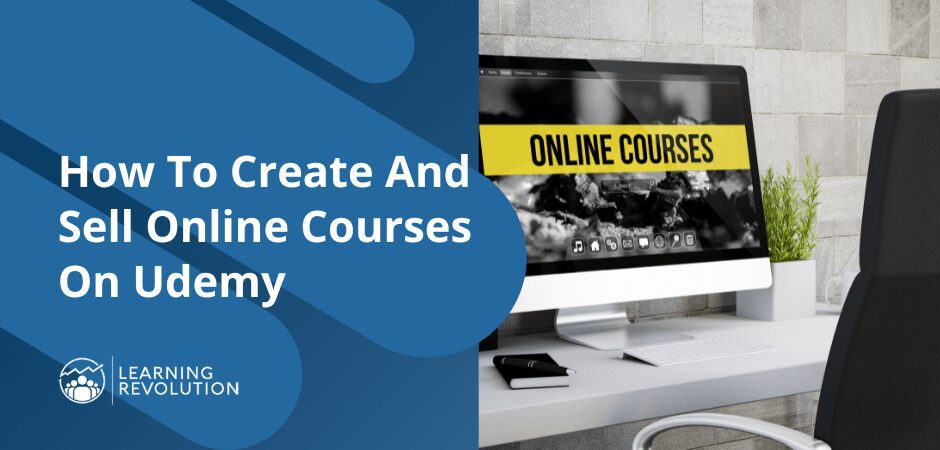

Did you know that Udemy paid its instructors a whopping $189 million in 2022? As the world’s largest online course marketplace, Udemy is the perfect platform for professionals and experts to monetize their knowledge and skills by selling online courses.
It allows you to share your expertise with millions of learners across the globe without worrying about building a website, purchasing web hosting services, or marketing your course.
You only need to focus on creating the best course on your topic, and Udemy takes care of everything else.
However, with over 70K registered teachers and 200K courses, Udemy is a competitive platform where your course will only get attention if you build it with the right strategy.
In this detailed guide, we’ll walk you through the process of creating a successful Udemy course by finding the right niches and topics, designing high-quality content, and optimizing your course listing to rank higher in Udemy’s platform searches.
Let’s get started.
Why Sell Courses On Udemy | Pros And Cons
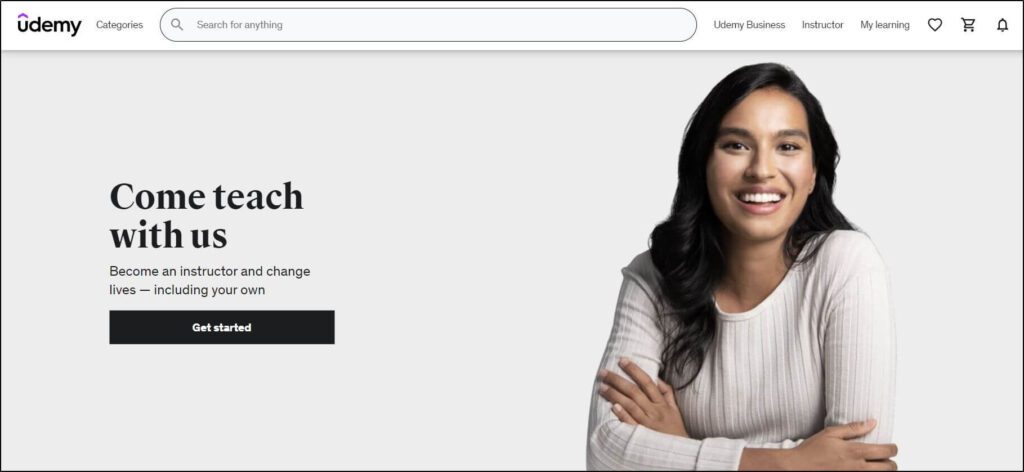

Let us give you a quick overview of the main advantages and disadvantages of selling courses on Udemy.
| Pros | Cons |
|---|---|
| Udemy has a low entry barrier, so anyone can publish a course as long as it meets the quality guidelines | Udemy only supports recorded online courses and limited product types. For example, no live courses, one on one coaching, or recurring memberships |
| You can publish Udemy courses without any upfront payments or recurring fees. Instead, Udemy charges a portion of your course price on every sale. | Udemy isn’t designed for advanced courses or eLearning programs with extensive professional training. Instead, it mainly targets beginner learners. |
| Publishing a Udemy course gives you access to the platform’s 100 million monthly visitors | It offers a very limited scope for personal branding. |
| Udemy actively promotes and markets your courses to relevant audiences through email and ad campaigns | You cannot access the email addresses of your Udemy course participants |
| Udemy’s algorithms recommend your courses to relevant learners on its platform | |
| People trust Udemy and buy its courses with confidence |
Udemy Course Ideas: The Best Niches For Selling Online Courses On Udemy
Udemy features courses in dozens of categories and sub-categories. Each sub-category has courses on specific topics.
You can see the most popular course topics by going to the Categories→Subcategory menu.
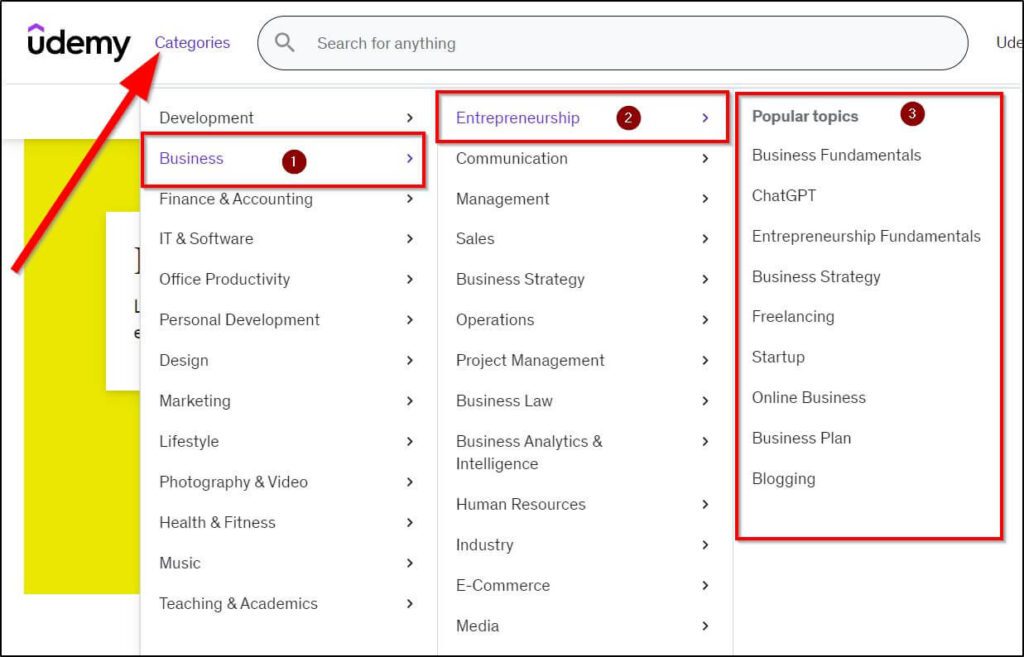

Udemy has a dedicated Popular And Trending Topics page where you can find the best-selling course topics on the platform.
But in general, here are the most popular Udemy niches where the most courses are sold.
- Programming and development (Python, SQL, Ruby On Rails)
- Machine learning and AI
- Microsoft Excel
- Project Management
- Business Management
- Business Communication
- SEO & Digital Marketing
- Personal Development
- Investing & Trading
- Video And Audio Editing
- Graphic Design Skills
Each of these categories has numerous topics that you can target to create successful Udemy courses.
Udemy Course Creation Guide: 18 Steps To Make Your First Course
Let’s now dive into the process of creating a successful Udemy course that ranks well on the platform, attracts learners, gives them real actionable value, and, in the process, helps you make money.
Step 1: Understand Udemy’s Course Quality Requirements
Udemy has a low entry barrier which means you don’t need to have years of experience in a topic to create a course about it.
But it still has some content quality guidelines that you must follow to publish courses.
- Every course must have at least 30 minutes of video content
- Your course should have a minimum of 5 lectures
- Your content should be in HD video quality (720p or 1080p).
- Your course audio should be clearly audible.
- And most importantly, your course content should be accurate and high quality.
Udemy’s quality assurance team manually reviews every course before approving it to be listed on the platform. You can find the complete list of content guidelines here.
There’s nothing too strict about these guidelines, but you must carefully read them to ensure your course ticks all the boxes.
Step 2: Understand Udemy’s Revenue Share Model
How much does Udemy pay you for selling courses? Let’s quickly understand its revenue share model.
Udemy doesn’t charge you for creating or listing courses. Instead, you share a percentage of your revenue on every sale depending on who brought the customer.
- You keep 97% of the course sales price if the customer comes through your referral link or coupon.
- Udemy keeps 63%, and the instructor gets 37% of the course price if the customer comes directly to Udemy from a Udemy advertising campaign, partnership, referral, or any other scenario where the instructor’s link or coupon is not used.
So, if you have an email list or social media audience, you can potentially keep the bulk of the money from your Udemy course sales.
Step 3: Choose Your Online Course Niche
Udemy courses aren’t degree programs spread over months.
The most successful courses on Udemy are focused on specific topics and provide actionable value to the learners through bite-sized lectures and lessons that can be completed in 2-3 hours max.
So, if you want to succeed on Udemy, go beyond generic and broad topics, and create focused courses on well-defined topics.
For example, instead of a course on SEO, create “Technical SEO for eCommerce” or “On-Page SEO for Affiliates”. Similarly, instead of a generic course on Marketing, target a topic like “SaaS Lead Generation Strategies”.
Thankfully, you don’t need to guess your way through niche selection.
Instead, you can find specific niches and topics using the following methods.
1. Udemy Search Bar
Type your topic in Udemy’s Search Bar to get keyword suggestions and course ideas.
For example, here’s what the search bar shows when you type “freelance”
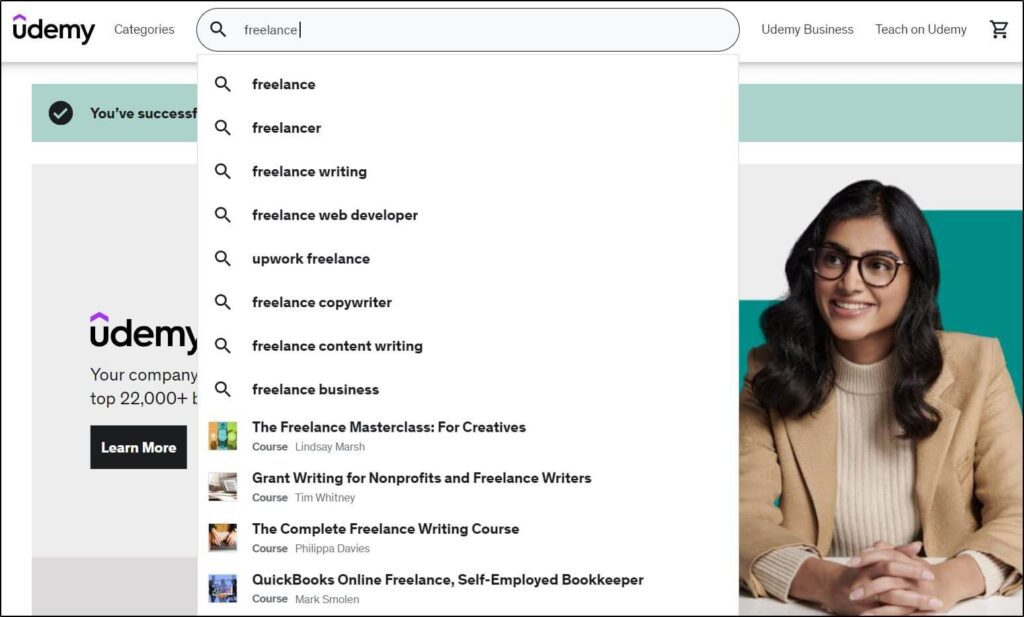

When we add another word to my search (freelance writing) more suggestions come up.
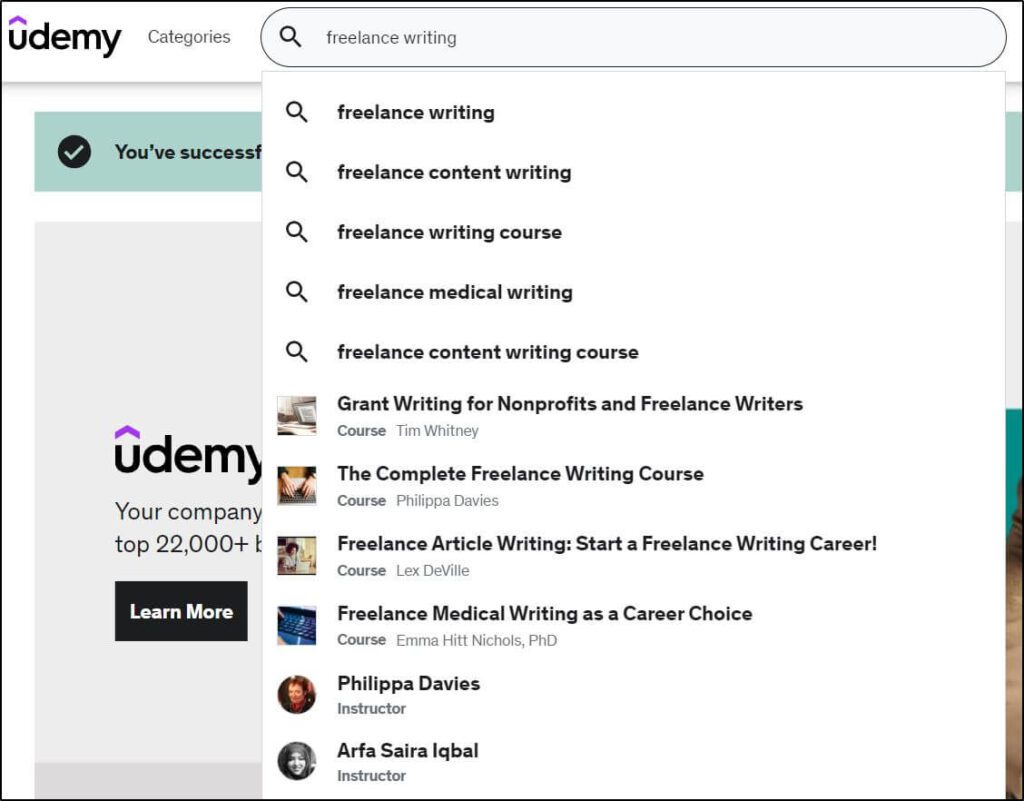

Plus, you can see the top courses and instructors about this topic. Try different keyword combinations to unearth new topics that Udemy users search.
2. Category Menu
We’ve already discussed this method. Just go to the Category — Sub-category menu to see dozens of different topics in your interest areas.
A word of advice, though.
When finding course ideas, stick to your areas of expertise where you can deliver real value. Because when you create high-quality courses, your students spread the word about them and drive referral traffic.
Don’t jump into every trending niche, even if you know nothing about it, just because it is popular. Build an identity and be known for 2-3 closely related niches.
Step 4: Use Udemy Marketplace Insights To Check Demand
Using Udemy Marketplace Insights is a more advanced way to find winning course ideas.
Udemy has designed this tool specifically for course creators to:
- Find course ideas and trending topics.
- Gauge the demand, competition, and revenue potential of a topic.
You can see the list of the hottest Udemy course topics on the homepage of Marketplace Insights.
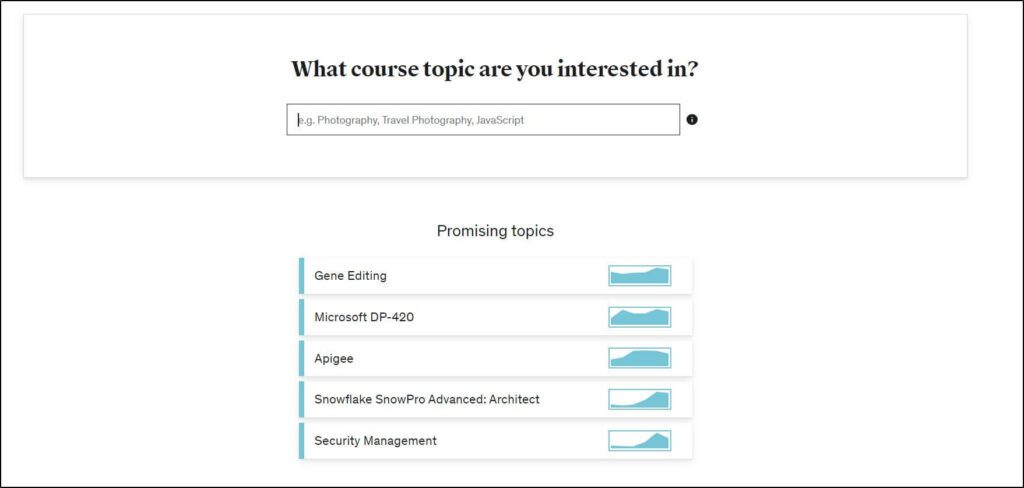

You can either click on the trending topics to explore more or enter your topic of interest in the search bar.
For example, this is what happens when you start typing “Photography” in the search bar.
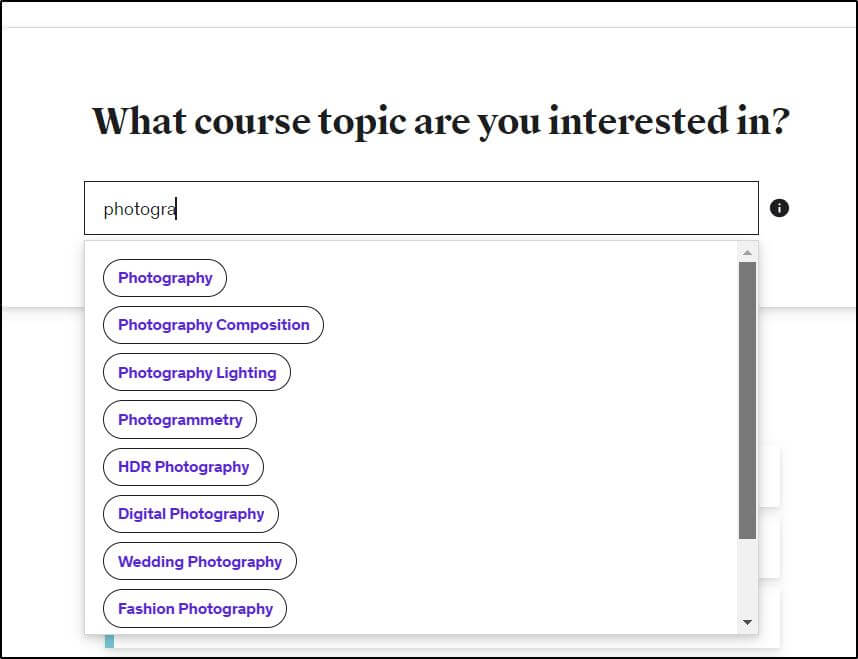

Udemy shows the sub-categories of photography to help us refine our search. They’re important because the students in every category have different needs.
To be successful, you must create a course on a specific sub-category of photography instead of a generic course.
Let’s choose Digital Photography.
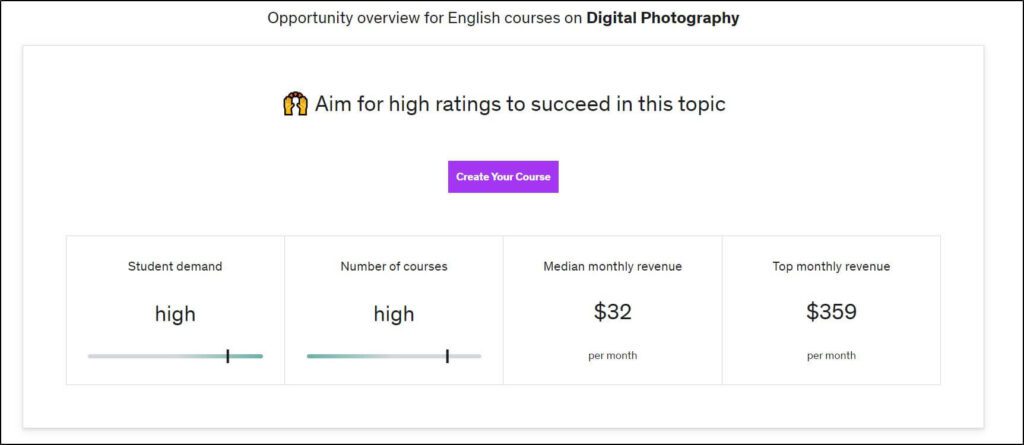

When you click on Digital Photography, Udemy Insights gives an overview of this topic on its platform.
As you can see, there’s high demand but there’s also stiff competition. You can also see the median and top monthly revenues in this topic category.
This instantly tells you whether there’s demand for your topic on Udemy and how much money you can make from your course.
But there’s more.
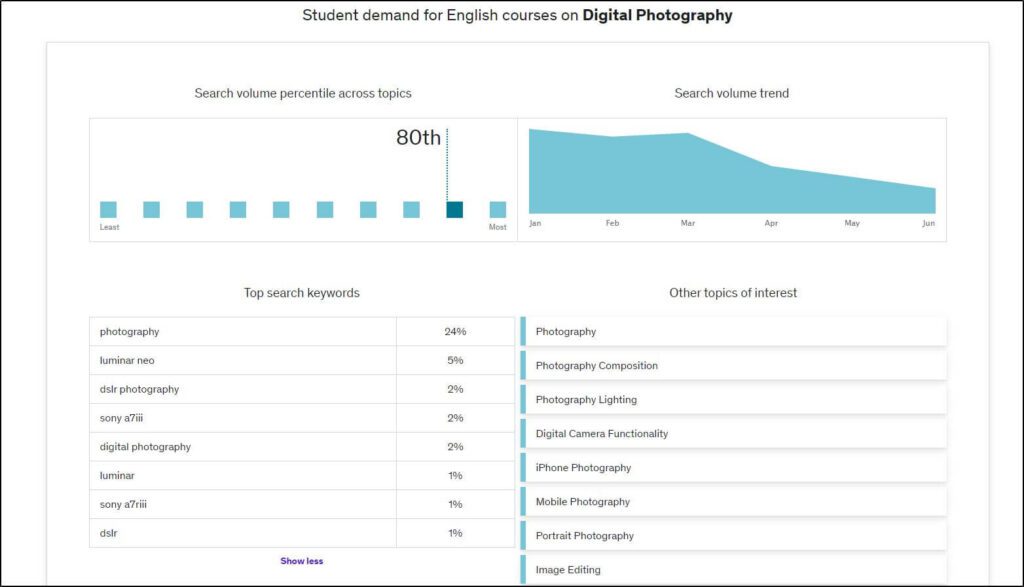

As you scroll down, Udemy shows you two critical pieces of information.
The search trend for your topic and its related keywords and sub-topics.
You can see a downward search trend for Digital Photography on Udemy. Plus, you can see the exact keywords searchers use to look for digital photography courses.
If your topic is too competitive, not profitable enough, or doesn’t have enough search demand, you can explore its related topics.
In short, this tool not only helps you determine if creating a course on a topic is profitable but also helps you find new course ideas in your niche.
So, make sure you spend time exploring different course ideas with this tool before finalizing a topic.
Step 5: Analyze Successful Udemy Courses
Stay on the Marketplace Insights page because when you scroll past the stats sections, Udemy shows you the top-earning courses in your category.
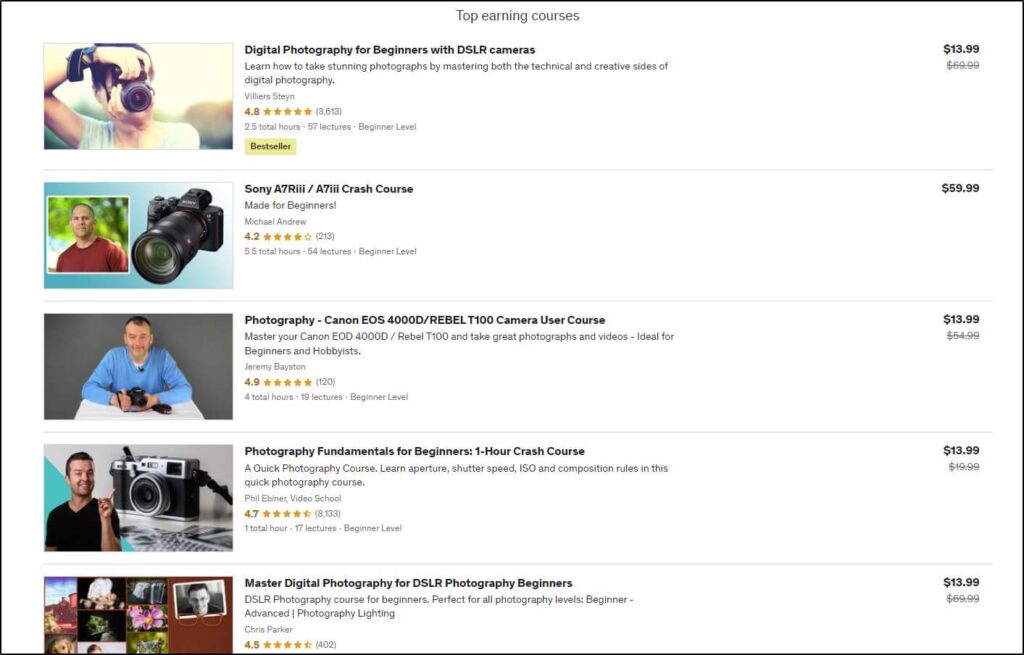

Open these courses in separate tabs and evaluate the following.
- The course outline to see what topics are covered.
- The number of modules and lessons, and they’re structured.
- Student reviews, to see what the most and least satisfied students say about the course. This section would help you find the strengths and weaknesses of the top earning courses. You can use these insights to create a better course.
These are the most successful courses on your topic. So, carefully analyze before creating your own course.
Step 6: Understand Your Audience’s Needs
Now that you’ve chosen a niche and have insights on your topic, it’s time to understand your audience’s questions and needs.
This is important because unless you know the exact questions of potential customers, you won’t be able to answer them in your course.
Here are the places to get deeper audience insights.
Student Review: We’ve already covered this in the last section. If you pay enough attention, you’ll find most of your audience’s questions in the reviews section.
Google Search: Use Google Search Autocomplete to find the keywords your audience searches on your topic.
Let’s search for digital photography again.
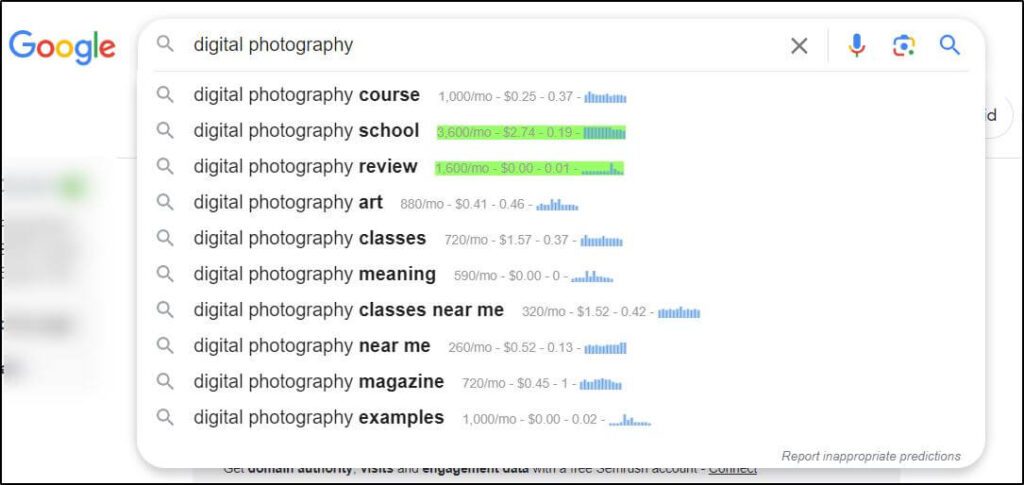

We use a very handy Chrome Extension, Keywords Everywhere that shows every keyword’s monthly search volume and search trend. It costs $10 but helps you identify topics with high demand much faster.
To get more keywords, add question words before your search term.
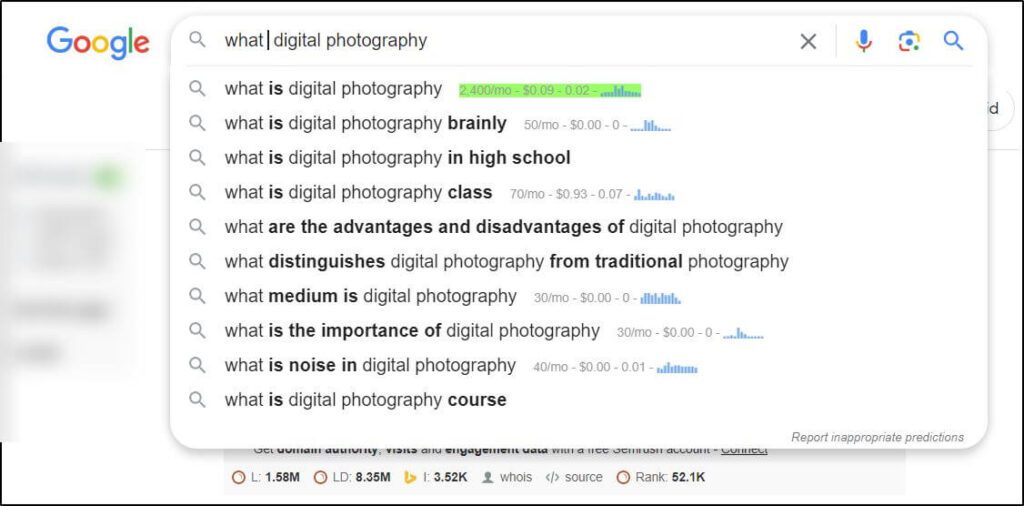

Use this method for any topic or keyword to find people’s questions about it. The more specific search terms you enter, the better questions you’ll find.
Gather these insights in a spreadsheet and use them while designing your course content.
Step 7: Define The Scope And Learning Objectives Of Your Course
This step is very important.
You must clearly define the scope of your course and what you want to cover in it. What will students learn by doing your course?
This not only helps your prospects understand your course’s value but also allows you to stay on track while designing your content.
For example, SEO is a broad topic.
When you create a course about SEO, you must define whether you’ll cover a specific part of SEO (like on-page, technical, or off-page SEO) or everything related to it.
On Udemy, it’s always better to create courses on specific topics.
So, if you create an SEO course, narrow down the scope to individual parts of SEO like link building, content creation, keyword research, or speed optimization, instead of designing one big SEO course that covers everything from A to Z.
Step 8: Identify Your Course’s Unique Selling Point
No matter what topic you choose, you’ll find dozens of courses about it on Udemy.
What makes your course difference? Why should anyone enroll in your course instead of the one with more reviews? What’s your unique selling point (USP)?
In an online course marketplace like Udemy, answering these questions is critical for your success.
So, how can you make your course different? Here are a few ideas.
- Deliver higher quality content by sharing more actionable insights
- Share more updated information
- Provide more practical examples
- Share personal findings or case studies no one has heard.
- Include more quizzes and assignments
- Include bonuses
- Include expert sessions/interviews
- Provide consultation or forum access
You must find ways to make your course more valuable so that your prospects have a strong reason to learn from you than your competitors.
Step 9: Create A Course Curriculum Outline
You’ve chosen your niche, finalized your topic, and defined the scope of your course.
Now, it’s time to start creating content.
But first, you must outline your course and define its structure so that you can easily fill in the required information.
Here’s what you need to decide in your online course outline.
- The number of modules in your course.
- The number of lessons in each module.
- The average length of each lesson
Here’s an example of a course outline from a Udemy course about building a photography business.
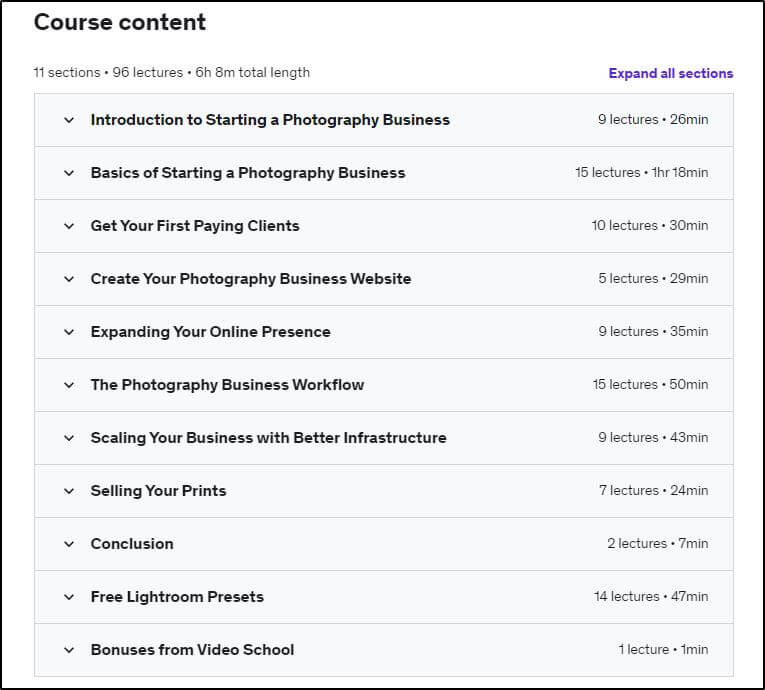

This course has 11 sections/modules and 96 lessons.
Here are the lessons in one of the modules.
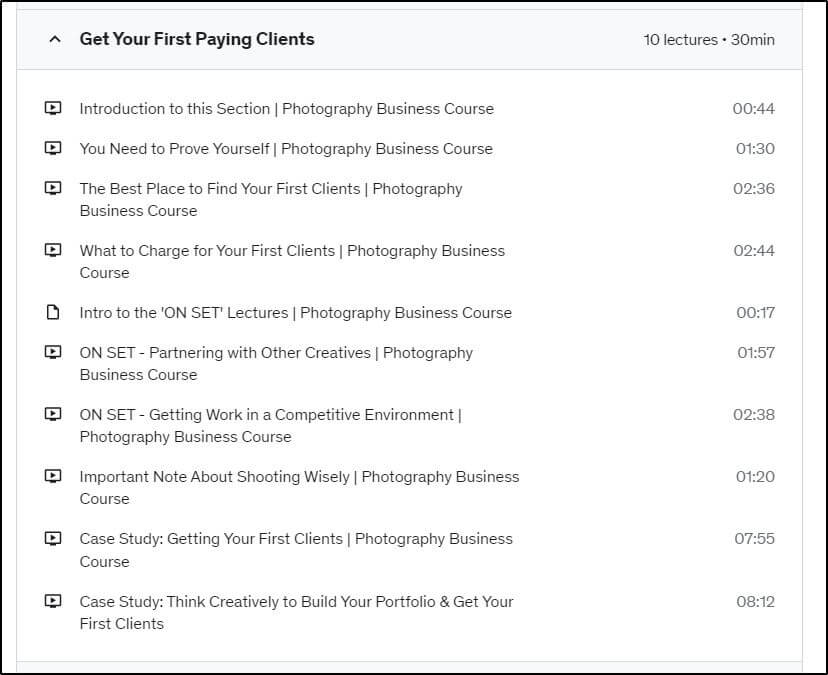

You’ll create a course outline using the top-down approach.
First, write down the core learning outcome/goal of your course.
Then identify the main segments or parts of your course. These will be your modules.
Then list down the components of each module. They’ll be your lessons.
Every module should focus on one aspect of your course. And each lesson should be a short (under three minutes) and actionable piece of information that takes your student one step closer to the module’s goal.
Step 10: Write The Script For Your Video Course Lessons
Next, write the script for each lesson of your course to ensure you cover all the important information about your topic. It also helps you communicate your content professionally with minimum edits and mistakes.
We’ve written a detailed scripting guide for podcasts. But its principles apply to online video courses as well.
So, check it out for more scripting tips and techniques.
Step 11: Design Quizzes and Assessments
Quizzes and assignments make your course more engaging, help your course participants stay focused, and allow you to gauge their understanding of the topic.
Ideally, every module of your course should have at least one quiz and assignment. Depending on the nature of your course, you also make an assignment or quiz mandatory to unlock the next lessons and modules.
Udemy allows you to create quizzes using its online course builder, which we’ll discuss later in the post.
Read our detailed guide for creating engaging online course quizzes for more detail on this topic.
Step 12: Choose Your Audio/Video Recording Equipment
The audio/video quality of your Udemy course has a huge impact on its engagement level and success rate. Udemy has a video resolution requirement of 720P. But it supports higher resolutions as well.
Whether you appear in your course videos or record a screencast, your video, and audio should be top quality.
To achieve great quality, you’ll need the right camera, mic, lighting, and other necessary equipment for video recording.
We’ve published a detailed guide about audio and video recording equipment, which includes options for different budgets and end-users. Do check it out for specific product recommendations.
Step 13: Record Your Udemy Course Content
Finally, it’s time to film your Udemy course content.
If you’ve followed the steps so far, you’ll know exactly what to say on camera and how to deliver real value to your learners.
If you’ll appear on camera (which is always more engaging for online courses), make sure you’re in a well-lit room with no outside noise and distractions.
Here are a few tips to remember while recording your course.
- Record one lesson at a time.
- Be relaxed, have a smiling face, and have an energetic tone to keep your students engaged.
- Don’t speak too fast, or your students won’t be able to follow.
- Don’t worry about mistakes, you can edit them later.
You’ll take longer to record your content than a pro if this is your first video course. But don’t aim for perfection. As long as your video is free of mistakes, delivers the promised content, and is clearly audible, use it without second thoughts.
Step 14: Edit Your Course Content
Editing will transform your content into a professionally produced online video course.
Here are a few video editing tips to remember
- Use the best video editing software to polish your content.
- Add your name card (with your website and social media links) to every lesson.
- Add your brand logo to the lessons.
- Remove long pauses or unnecessary sections that don’t add any value to the user experience.
- Use your intro graphic and music for the first lesson of every module. In other lessons, dive right into the content.
While editing your course, keep the original files in a folder and save the edited course files separately. This will allow you to come back to the source files if you need them for any other project.
Step 15: Submit Your Test Video To Udemy For Feedback
Before editing your full course, edit a few lessons and submit them to Udemy’s Test Video page for feedback.
This is Udemy’s free service to help new course creators create better content. You can get feedback on things like your equipment quality, speaking style, lighting, content quality, or any other aspect of your recording.
Step 16: Use The Udemy Course Builder To Upload Your Content
Once your course is ready, you can submit it to Udemy for review before publishing. Udemy has a robust online course builder that allows you to easily create your course modules, upload lessons, add quizzes and assignments, and manage other aspects of your course.
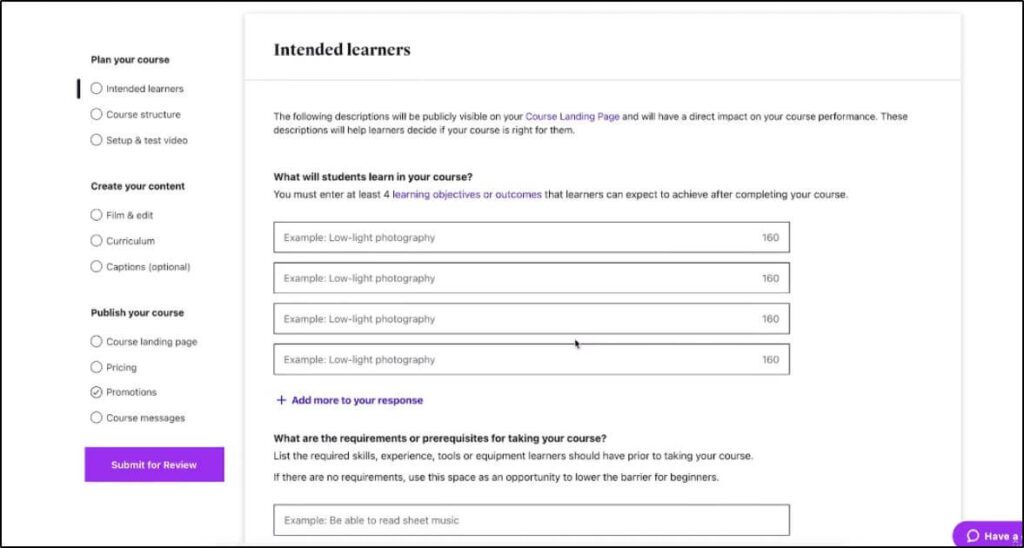

You can access the course builder from the Instructor’s Admin area in your Udemy account.
It has multiple sections like Intended Learners, Course Outline, Description, etc. where you’ll enter the information we’ve already covered in this article.
You’ll create your course modules and lessons in the Curriculum section.
Here, you’ll first create Sections/Modules and add lectures/lessons to them. A lesson can be a lecture, a quiz, a file, a test, or an assignment.
Add the description for each lesson to tell your students what to expect.
Once you upload all the modules and lessons, move to your course landing page.
Step 16: Create A High Converting Udemy Course Landing Page
Your Udemy course landing page is where your prospects will find all the relevant information about your course, what it offers, and how it’s different from other courses.
Udemy has a standard landing page template, so there isn’t much room for creativity.
All the sections of your landing page are presented as separate fields in the course builder where you can enter the relevant information.
Describe your course in detail and highlight its core strengths in bullet points so your prospects can quickly read them.
Step 17: Set Your Course Price
You’re still inside Udemy’s course builder, and now it’s time to price your course.
Udemy courses are generally priced lower than standalone premium courses on dedicated online course platforms. Most classes are priced between $11.99 to $200.
So, closely analyze your competitors’ pricing strategy before finalizing a rate.
Many experienced Udemy sellers also recommend offering your first course free to generate leads and reviews for future courses.
This online course pricing strategy guide shares more tips.
Step 18: Create A Course Trailer
If you want your online course to stand out on Udemy, create a high-quality trailer for your landing page.
Your online course trailer is a short video describing your course’s main benefits, advantages, and learning outcomes.
It is your chance to make an impression on your prospects and turn them into customers.
Here’s an example from a best-selling copywriting course on Udemy:
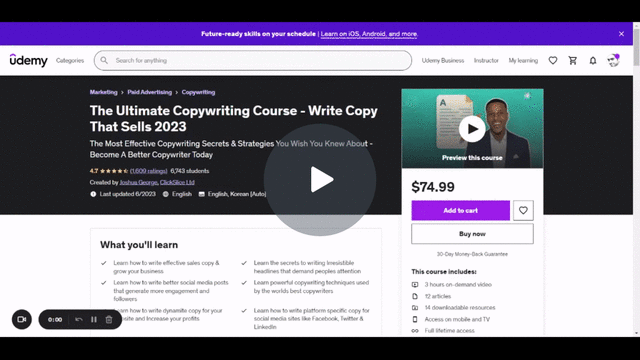

Your course trailer is an excellent selling tool, especially if you don’t have any reviews yet and want to make an impression on your prospects. So, create a 1-2 min trailer highlighting your course’s USP and why learning from you is the right decision.
Promote Your Udemy Course To Grow Sales
Creating your first Udemy course is a significant achievement. It’ll teach you a lot about content creation and how to create winning digital products.
But once you publish your Udemy course, use promotions, coupons, discounts, and referral links to promote your course. If you have an email list or a sizable social media following, tell them about your new course. You may even offer free subscriptions for a limited time to gain early momentum since free Udemy courses attract a lot of visitors.
As students sign up for your course, actively engage with them, answer their questions, and encourage them to leave positive reviews and spread the word about your course.
And finally, don’t stop at your first course. Use your experience of launching this course to publish more courses. Because as your course library grows, you can generate a significant passive income from Udemy.
Let us know if you have any questions.
How To Make A Udemy Course | Frequently Asked Questions (FAQs)
You can sign up as an Udemy Teacher on the website.
The most successful Udemy courses consist of short (2-3 min) lessons contained in multiple modules. The total length of the course should ideally be around 2-3 hours.
Publishing a course on Udemy is FREE. But you’ll have to bear the course production costs.
Yes, Udemy pays millions of dollars every year to its instructors as course fees.
Table of Contents




